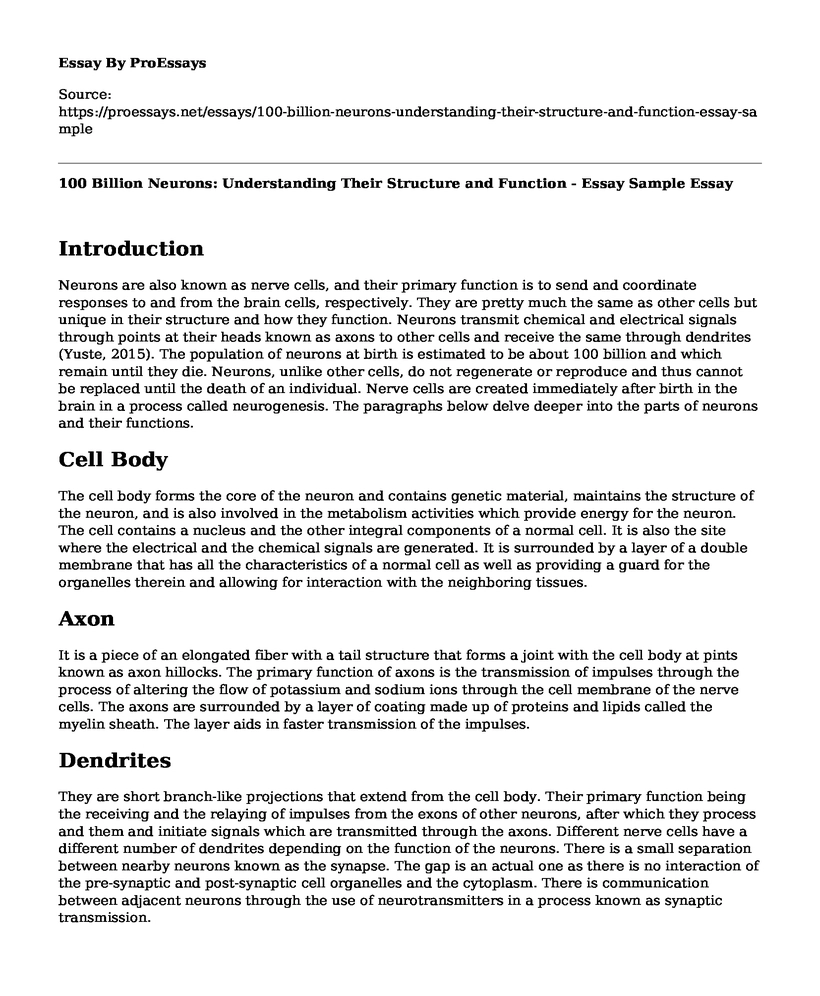Introduction
Neurons are also known as nerve cells, and their primary function is to send and coordinate responses to and from the brain cells, respectively. They are pretty much the same as other cells but unique in their structure and how they function. Neurons transmit chemical and electrical signals through points at their heads known as axons to other cells and receive the same through dendrites (Yuste, 2015). The population of neurons at birth is estimated to be about 100 billion and which remain until they die. Neurons, unlike other cells, do not regenerate or reproduce and thus cannot be replaced until the death of an individual. Nerve cells are created immediately after birth in the brain in a process called neurogenesis. The paragraphs below delve deeper into the parts of neurons and their functions.
Cell Body
The cell body forms the core of the neuron and contains genetic material, maintains the structure of the neuron, and is also involved in the metabolism activities which provide energy for the neuron. The cell contains a nucleus and the other integral components of a normal cell. It is also the site where the electrical and the chemical signals are generated. It is surrounded by a layer of a double membrane that has all the characteristics of a normal cell as well as providing a guard for the organelles therein and allowing for interaction with the neighboring tissues.
Axon
It is a piece of an elongated fiber with a tail structure that forms a joint with the cell body at pints known as axon hillocks. The primary function of axons is the transmission of impulses through the process of altering the flow of potassium and sodium ions through the cell membrane of the nerve cells. The axons are surrounded by a layer of coating made up of proteins and lipids called the myelin sheath. The layer aids in faster transmission of the impulses.
Dendrites
They are short branch-like projections that extend from the cell body. Their primary function being the receiving and the relaying of impulses from the exons of other neurons, after which they process and them and initiate signals which are transmitted through the axons. Different nerve cells have a different number of dendrites depending on the function of the neurons. There is a small separation between nearby neurons known as the synapse. The gap is an actual one as there is no interaction of the pre-synaptic and post-synaptic cell organelles and the cytoplasm. There is communication between adjacent neurons through the use of neurotransmitters in a process known as synaptic transmission.
The Process of Neurotransmission
The journey of an electrical impulse through the axon to the terminals of the nerve provokes the removal of neurotransmitters from the movement of the vesicles in the terminal. They are diffused across the synapse from the pre-synaptic cell to the dendrites in the post-synaptic cells. While there, the neurotransmitters bind with specific receptors that are unique to each neurotransmitter from which electrical or chemical signals are generated in the post-synaptic cells depending on the bound. Excited neurotransmitters enhance the flow of electric signals in the receiving cell while inhibitory cells reduce the transmission. The neurotransmitter may trigger an action potential in the post-synaptic nerve cell, continuing the communication or may not. A short period elapses after the binding where the neurotransmitters are either broken down by the enzymes in the post-synaptic nerve cell or taken back to their origin.
References
Yuste, R. (2015). From the neuron doctrine to neural networks. Nature reviews neuroscience, 16(8), 487-497.
Cite this page
100 Billion Neurons: Understanding Their Structure and Function - Essay Sample. (2023, Apr 26). Retrieved from https://proessays.net/essays/100-billion-neurons-understanding-their-structure-and-function-essay-sample
If you are the original author of this essay and no longer wish to have it published on the ProEssays website, please click below to request its removal:
- How Does Bioethics Affect the Development of Stem Cell Research?
- Genetic Technologies for Effective Care Essay
- Essay Sample on Dairy Farming Facilities and Staffing
- Essay on the Interconnectedness of Animal Diseases: An Analysis of Quammen's Spillover
- Essay Sample on Exploring the Role of the Appendix in the Human Body
- Nature vs Nurture: Pre-Wiring and Life Experiences - Essay Sample
- Altitudinal Migration in East African Birds: A Comprehensive Ringing Recovery Study







